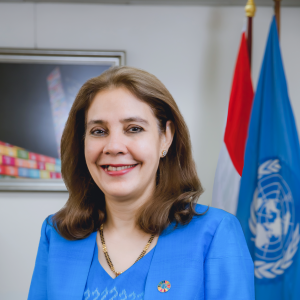I am delighted to be back here in Bangkok where I spent four wonderful years working in close partnership with government in advancing sustainable development, climate action and inclusion in line with the SDGs.
I see many familiar faces here and I would like to thank you for coming.
As you know, a robust evidence base is critical to SDG acceleration.
ESCAP’s contribution is exemplified by this annual report on SDG progress bringing cutting-edge expertise to bear on tracking indicators and targets to identify priorities for acceleration nationally.
Let me thank Rachel for presenting the report’s findings.
These findings deepen analysis on each of the 17 goals, leveraging quantitative and qualitative data.
This enables informed and targeted policymaking, which is critical for fast tracking SDGs by 2030.
I would like to share three takeaways from my perspective as a Resident Coordinator.
One, the SDG progress snapshot is a strategic tool that is easy to understand.
It is used for informing political leaders and top policy-makers about goals that are on track and those that require further attention and investments.
I know the value of these snapshots firsthand, having used them in my role as Resident Coordinator first in Thailand and now in Indonesia during my dialogues with political leaders.
Encouragingly, countries are increasingly adopting this approach, integrating national data points and targets into development frameworks.
Ten countries in Asia and the Pacific already use the SDG trackers in their Voluntary National Reviews, and more countries are planning to use, including Indonesia and Thailand.
Two, as Rachel has pointed out, Asia and the Pacific has done well on 10 of the 17 goals, outperforming all other regions.
One goal that requires major acceleration is climate action.
That was surprising to me because we are seeing an increasing balancing of sustainability and economic growth in Asia and the Pacific.
This lack of progress on climate action highlights the urgency for concerted efforts to reduce GHG emissions.
This is especially critical in the context of the upcoming COP30, where governments will be setting out their most ambitious targets on carbon neutrality for climate action to go further and faster.
Three, the SDGs end in 2030 and yet the region as a whole still lacks sufficient data to measure progress on Goal 5 on gender equality and Goal 16 on peace, justice and strong institutions.
As we have much work to do on both goals across the region, it will be crucial to gain a clear picture of rates of progress.
The current data gap will require custodian UN agencies to work closely with governments to look at alternative data sources.
Importantly, progress on the SDGs is impossible without whole-of-society approaches.
This is why the inclusion of community perspectives into the SDG report adds another dimension for the first time.
For instance, people living in slums and informal settlements are often invisible in official statistics.
To remedy this, the community-driven Know Your City initiative around the Asia-Pacific region collects citizen-led data to identify the needs of the poorest urban residents to inform interventions for more inclusive cities.
In Delhi, for example, data obtained this way were incorporated into official statistics to improve lighting in dark spots and boost nighttime safety.
This shows how community generated data can not only bridge gaps in official statistics but also capture how SDG progress affects people’s lives and livelihoods at a more granular scale.
ESCAP is also bolstering statistical systems by leveraging the Big Data Hub for Asia and the Pacific in support of the SDGs.
Big Data and machine learning can be used to test and scale up real-time information to track SDG progress in critical domains.
This includes assessing current rice production rates based on satellite imagery and analysing mobile positioning data to measure tourist numbers as part of compiling official statistics.
This is where the future of statistics lie given that a fifth of SDGs can be measured through Big Data.
However, leveraging machine learning for analyzing vast datasets necessitates upskilling among statisticians, data scientists, and computing specialists.
To that end, ESCAP is building the capacity of national statistics offices on machine learning across the region.
I hope that this report will be useful to you in understanding how we can leverage new data to track the SDGs and speed up progress on them.
At the UN we value our partnerships with you in the media and I would like to commend you on your commitment to the SDGs.
Thank you.
The Asia and the Pacific SDG Progress Report 2025 is available at bit.ly/SDG-Report2025


















